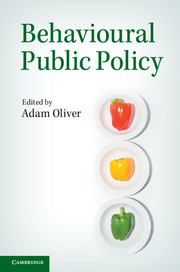Book contents
- Frontmatter
- Contents
- List of Figures
- List of Tables
- List of Contributors
- Introduction
- 1 Ambiguity aversion and the UK government’s response to swine flu
- 2 Models of governance of public services: empirical and behavioural analysis of ‘econs’ and ‘humans’
- 3 From irresponsible knaves to responsible knights for just 5p: behavioural public policy and the environment
- 4 The more who die, the less we care: psychic numbing and genocide
- 5 Healthy habits: some thoughts on the role of public policy in healthful eating and exercise under limited rationality
- 6 Confessing one’s sins but still committing them: transparency and the failure of disclosure
- 7 How should people be rewarded for their work?
- 8 Influencing the financial behaviour of individuals: the mindspace way
- 9 Decision analysis from a neo-Calvinist point of view
- Index
- References
2 - Models of governance of public services: empirical and behavioural analysis of ‘econs’ and ‘humans’
Published online by Cambridge University Press: 05 June 2014
- Frontmatter
- Contents
- List of Figures
- List of Tables
- List of Contributors
- Introduction
- 1 Ambiguity aversion and the UK government’s response to swine flu
- 2 Models of governance of public services: empirical and behavioural analysis of ‘econs’ and ‘humans’
- 3 From irresponsible knaves to responsible knights for just 5p: behavioural public policy and the environment
- 4 The more who die, the less we care: psychic numbing and genocide
- 5 Healthy habits: some thoughts on the role of public policy in healthful eating and exercise under limited rationality
- 6 Confessing one’s sins but still committing them: transparency and the failure of disclosure
- 7 How should people be rewarded for their work?
- 8 Influencing the financial behaviour of individuals: the mindspace way
- 9 Decision analysis from a neo-Calvinist point of view
- Index
- References
Summary
This chapter develops Le Grand’s argument about the need to recognize that those who choose to work in public services are not wholly ‘knights’ (Le Grand, 2003) driven by altruism, but are a mix of ‘knights’ (altruistic) and ‘knaves’ (selfish). He argued that choice and competition between schools and hospitals through quasi markets in which money follows the pupil or patient is the primary policy instrument to combat government failure. This is because quasi markets appeal to both knightly and knavish motives. They create pressure to improve services to respond to threats to market shares, providers’ incomes and hence jobs (Le Grand, 2007). The reason why we disagree with Le Grand in his proposed remedy to his diagnosis is that the choice and competition model assumes that people as users and providers of public services act as ‘econs’, as described by Thaler and Sunstein (2008), i.e. behave as in conventional microeconomics. We know that ‘humans’ behave differently, as has been demonstrated by carefully designed psychological experiments. Thus, although, if asked, people will say they desire more choice and believe that the greater the choice the better, there is ample evidence that in health care, just as in more mundane consumer choices (Iyengar and Lepper, 2000), users do not behave like econs and do not use information on provider performance to switch from those that are poor to those that are good. Instead of the choice and competition model, we see scope for developing the more psychologically plausible model of governance based on users and providers as ‘humans’, where users do not use public information on provider performance to switch between providers, but providers respond to threats to their reputation via public reporting of rankings of performance (Hibbard et al., 2003).
In this first section we present the four alternative models of governance: altruism, hierarchy and targets, reputation, and choice and competition.
- Type
- Chapter
- Information
- Behavioural Public Policy , pp. 38 - 68Publisher: Cambridge University PressPrint publication year: 2013
References
- 17
- Cited by



